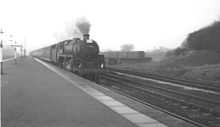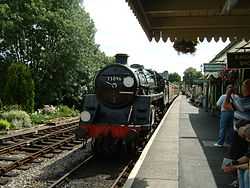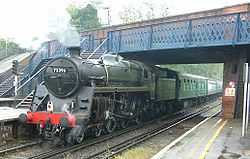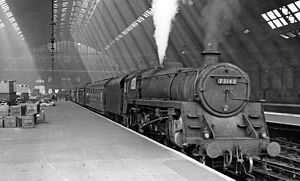BR standard class 5
| BR Standard Class 5 | |
|---|---|
|
No 73142 ready to depart with the 10.50 Express from London St Pancras to Leicester in 1957. Note the Caprotti valve gear. | |
| Type and origin | |
| Power type | Steam |
| Designer | R. A. Riddles |
| Builder |
BR Derby Works (130) BR Doncaster Works (42) |
| Build date | April 1951 - June 1957 |
| Total produced | 172 |
| Specifications | |
| Configuration | 4-6-0 |
| UIC classification | 2′C h2 |
| Gauge | 4 ft 8 1⁄2 in (1,435 mm) |
| Leading wheel diameter | 3 ft 0 in (0.914 m) |
| Driver diameter | 6 ft 2 in (1.880 m) |
| Length | 62 ft 7 in (19.08 m) |
| Width | 8 ft 9 in (2.67 m) |
| Height | 13 ft 0 in (3.96 m) |
| Axle load | 19.70 long tons (20.02 t) |
| Weight on drivers | 58.05 long tons (58.98 t) |
| Locomotive weight | 76.00 long tons (77.22 t) |
| Tender weight |
BR1/BR1H: 49.15 long tons (49.94 t); BR1B: 51.25 long tons (52.07 t); BR1C: 53.25 long tons (54.10 t); BR1F: 55.25 long tons (56.14 t); BR1G: 52.50 long tons (53.34 t); |
| Tender type | BR1 (50), BR1B (62), BR1C (35), BR1F (10), BR1G (3), BH1H (12) |
| Fuel capacity |
BR1C: 9.00 long tons (9.14 t); All others: 7.00 long tons (7.11 t) |
| Water capacity |
BR1/BR1H: 4,250 imp gal (19,300 l; 5,100 US gal); BR1B/BR1C: 4,725 imp gal (21,480 l; 5,674 US gal); BR1F: 5,625 imp gal (25,570 l; 6,755 US gal); BR1G: 5,000 imp gal (23,000 l; 6,000 US gal) |
| Boiler | BR3 |
| Boiler pressure | 225 psi (1.55 MPa) |
| Firegrate area | 28.7 sq ft (2.67 m2) |
| Heating surface: – Tubes and flues | 1,479 sq ft (137.4 m2) |
| – Firebox | 171 sq ft (15.9 m2) |
| Superheater area | 358 sq ft (33.3 m2) |
| Cylinders | Two, outside |
| Cylinder size | 19 in × 28 in (483 mm × 711 mm) |
| Valve gear |
Walschaerts (73000–73124, 73155–73171) Caprotti (73125–73154) |
| Performance figures | |
| Tractive effort | 26,120 lbf (116.2 kN) |
| Factor of adhesion | 4.97 |
| Career | |
| Operator(s) | British Railways |
| Power class | 5MT |
| Number(s) | 73000–73171 |
| Axle load class |
Route availability 7 BR (WR): Red |
| Withdrawn | February 1964 – June 1968 |
| Disposition | Five preserved, remainder scrapped |
The British Railways Standard Class 5MT 4-6-0 was one of the 12 standard classes of steam locomotive built by British Railways in the 1950s. It was essentially a development of the LMS Stanier Class 5 4-6-0 ("Black Five"). 172 were built between 1951 and 1957.
Background
William Stanier's Black Five had been the most successful mixed-traffic type in Great Britain. Construction of the Black Fives had started in 1934 and continued past nationalisation to 1951. A new set of 'standard' locomotives was to be built by British Railways, based on LMS designs and incorporating modern ideas.
In particular, the Standard design incorporated features designed to make disposal easier: a self-cleaning smokebox and a rocking grate removed the necessity for crews to undertake dirty and strenuous duties at the end of a long shift.[1] The Standard 5 was a much more economical high speed express engine than the Black 5. Like the "Clan" class locomotives, Standard 5s, with their high-stepped running board, were partly conceived to be far easier running replacements for the Bulleid Pacific. Like the Clans, the Standard Fives took a long time to shake down, and only started to really pull when different firing techniques, developed for low emission passenger locomotives, came into use. They pulled the bulk of the traffic on the last express lines for steam in the mid and late 1960's: Edinburgh- Aberdeen, London- Southhampton-Bournemouth- Weymouth; and local express traffic in the North and Midlands around Sheffield and Leeds. They were also used on the locals between Liverpool, Manchester and Blackpool, effectively steam hauled to the last day in 1968.
Design and construction
The design work was done at the ex-LNER Doncaster Works but the bulk of the construction was done at Derby Works. The locomotive featured a Type 3B boiler almost identical to that of the Black Fives. The most obvious visible changes were a higher running plate, slightly enlarged driving wheels (from 6 ft 0 in (1.829 m) to 6 ft 2 in (1.880 m)) and a standard cab.
The first of the class, 73000, was outshopped from Derby in April 1951 and 30 were in service by January 1952. There was then a gap in construction before Derby resumed building its remaining 100 engines. 42 were built at Doncaster, starting in August 1955 and finishing in May 1957, with Derby's last engine following a month later.
Thirty engines, numbers 73125 to 73154, were built with Caprotti valve gear and poppet valves. One of these engines (73129) survives today at Butterley. It and 71000 Duke of Gloucester are the only engines with Caprotti gear left in Britain.
In service
In 1959 20 of the Southern Region locomotives were named, the names being transferred from SR King Arthur class locos that were then being withdrawn. These were:
- 73080 Merlin
- 73081 Excalibur
- 73082 Camelot
- 73083 Pendragon
- 73084 Tintagel
- 73085 Melisande
- 73086 The Green Knight
- 73087 Linette
- 73088 Joyous Gard
- 73089 Maid of Astolat
- 73110 The Red Knight
- 73111 King Uther
- 73112 Morgan Le Fay
- 73113 Lyonnesse
- 73114 Etarre
- 73115 King Pellinore
- 73116 Iseult
- 73117 Vivien
- 73118 King Leodegrance
- 73119 Elaine

73020 is known to have been used on Southern Region, photographed departing Southampton Terminus on 18 September 1965.[2]
73022 has also been photographed in service on the Southern Region, pulling a Boat Train across Canute Road in Southampton on 29 September 1966.[2] This engine also starred in the BTC film Wash and Brush Up, showing the routine boiler washout and cleaning of the smokebox and ash screens every 12-16 days while in service. On completion of this, 73020 hauled the 12.10pm goods to Camden.
73114 Etarre has been photographed in service on 20 March 1966, pulling a Boat Train through Fareham while diverted due to electrification work on the Southern Region mainline from Southampton to London Waterloo.[2]
Accidents and incidents
- Main article: Eastbourne rail crash
- On 25 August 1958, locomotive No. 73042 was hauling a sleeper car train which overran a signal and was in a head-on collision with a train formed fron two electric multiple units at Eastbourne, East Sussex. Five people were killed and 40 were injured.
- In 1958, locomotive No. 73111 was hauling a passenger train that derailed at Millbrook, Hampshire due to a faulty point motor moving a set of points under the train.[3]
Preservation


Five have survived:
| Number | Name | Home | Notes |
|---|---|---|---|
| 73050 | - | Nene Valley Railway | Operational. Named City of Peterborough in preservation. |
| 73082 | Camelot | Bluebell Railway | Undergoing overhaul. Last worked 2005. Featured in 102 Dalmatians. |
| 73096 | - | Southall Railway Centre | Boiler ticket expired September 2011, stored awaiting overhaul. |
| 73129 | - | Midland Railway - Butterley | Operational. One of only 2 engines left in Britain with Caprotti valve gear. |
| 73156 | - | Great Central Railway | Undergoing restoration which includes a new tender and motion. |
Notes
- ↑ Terry Essery, Steam Locomotives compared, Atlantic Transport Publishers, ISBN 0-906899-65-6
- ↑ 2.0 2.1 2.2 South Coast Railways - Portsmouth to Southampton. Vic Mitchell and Keith Smith. 1986. ISBN 0-906520-31-2
- ↑ Bishop, Bill (1984). Off the Rails. Southampton: Kingfisher. pp. 76–77. ISBN 0 946184 06 2.
References
- A Detailed History of BR Standard Steam Locomotives, - Vol 2 - The 4-6-0 and 2-6-0 Classes. RCTS ISBN 0-901115-93-2
- Bradley, Rodger P. (1984). The Standard Steam Locomotives of British Railways. David & Charles Publishers plc.
External links
| Wikimedia Commons has media related to BR Standard Class 5MT. |
| ||||||||||||||
